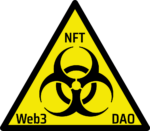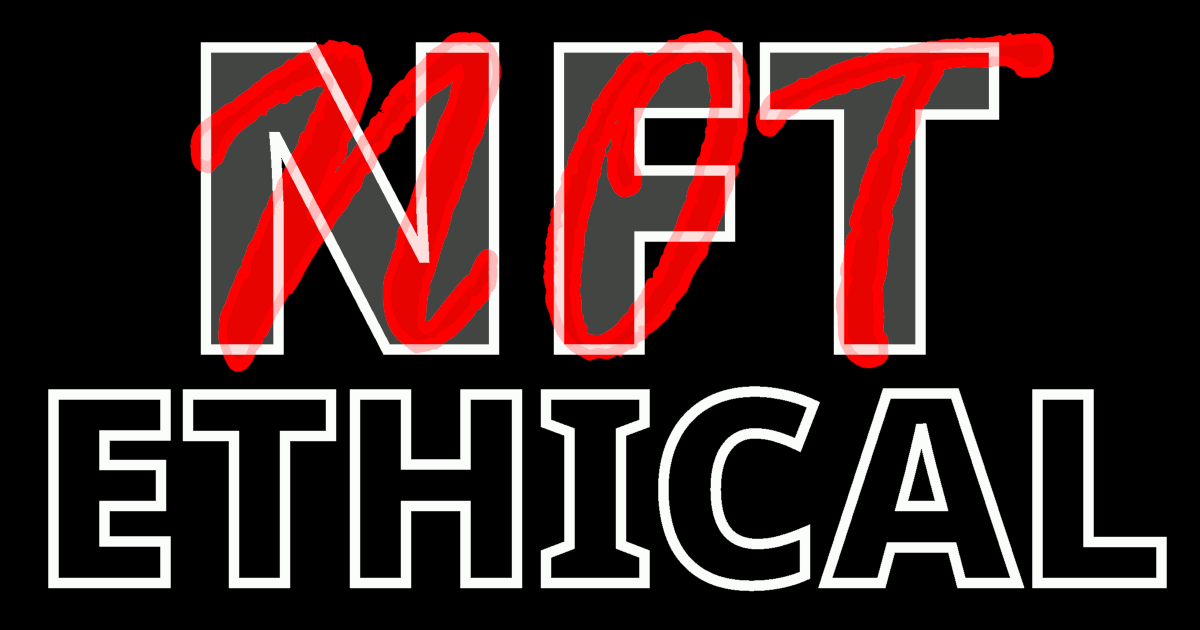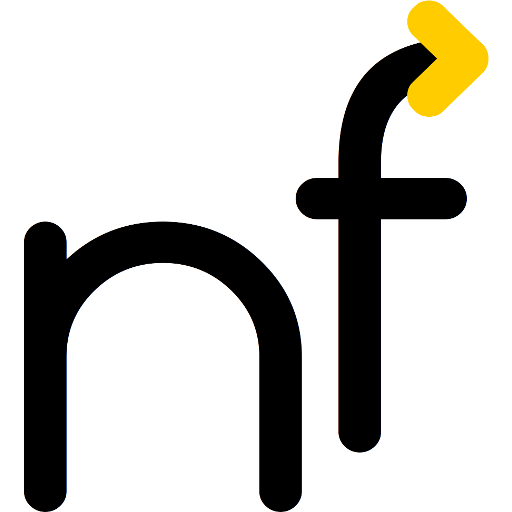As an avid reader, you know my arguments that neither NFT nor smart contracts live up to their promises, and that the blockchain underneath is also more fragile and has a worse cost-benefit ratio than most believe. Similarly, I also claim the same for the metaverses built on top of them all. And that the promised efficiencies from blockchains often benefit criminals. Nothing new so far.
But did you know that NFTs are not ethical? That’s exactly the result of a study I’ve finally been reading and whose results I am going to share here.
This text also appeared in German 🇩🇪 : «NFT sind nicht ethisch» (long) and «18 Gründe, wieso NFT unethisch sind» (short)
Catherine Flick, a then Reader in Computing & Social Responsibility at De Montfort University, published “A Critical Professional Ethical Analysis of Non-Fungible Tokens (NFTs)” last December. In it, she takes on the code of ethics of the oldest scientific society in computer science, the ACM. On the basis of this code, she systematically analyzes the properties of NFTs.
Research questions
Her approach shows her analytical background. She starts with a main question, which she divides into two sub-questions:
- Are non-fungible tokens (NFTs) an ethical technology?
- What ethical issues do NFTs raise, according to a professional ethic?
- How could NFTs be implemented so that they don’t have these problems?
The Code of Ethics
From the Codes of Ethics related to computer science professionals, she chooses the one from the Association for Computing Machinery (ACM) mentioned above because it
- similar to the code of other informatics organizations,
- has been adopted by other organizations and
- strikes a good balance between abstraction and level of detail. (This point is of importance when you want to actually use the Code as a tool for analysis.)
Besides these perfectly valid objective arguments, I presume that she also chose the ACM Code of Ethics because she knows it like the back of her hand, having been on the committee drafting it.
The Code is divided into 25 thesis, grouped into 4 chapters. The Code’s theses are formulated as a call to take responsibility, which should be read as a continuation of a sentence such as “A computing professional should…“. Each of the theses are then followed by an explanation.
Principles
The well-founded analysis of the principles takes up 6 pages in Flick’s NFT ethics article. Here, therefore, only a few important points in brief. For the complete list, justifications, backgrounds and analysis, please directly refer to the paper.
The summary below is structured as follows for each thesis:
- The title of the corresponding thesis, with a link to its explanation.
- How this thesis is violated by NFTs. This part is highlighted in color in each case.
Note: The evaluation of a technology as a whole may differ from the evaluation of an individual product created in this technology space. Thus, individual NFT projects may well perform better or worse in individual areas than this overall evaluation yields. This necessary generalization nevertheless provides an important start for a more detailed and concrete discussion.
Thesis 1.1: [A computing professional should] contribute to society and to human well-being, acknowledging that all people are stakeholders in computing.
NFTs do not really contribute to the welfare of society, as they bring unfairness by means of fraud, “rug pulls” or “the last one bites the dog”.
Thesis 1.2: …avoid harm.
Through promises that are not kept (and cannot be kept), NFTs even actively harm poor or vulnerable people who, according to the Code, should be given very special protection. The damage can be both financial and psychological.
Thesis 1.3: …be honest and trustworthy.
The promises of NFTs are unrealistic or impossible to fulfill, going beyond what is technically or socially realistic and feasible. Therefore, computer professionals implementing NFTs violate the Code’s requirement for honesty and trustworthiness.
Conflicts of interest are rampant, transparency is undesirable.
Thesis 1.4: …be fair and take action not to discriminate.
Even if one would like to correct wrong behavior: Fairness cannot be demanded; also goodwill is not intended and often even technically impossible.
Blockchain technology encourages and perpetuates harassment and bullying because the platforms do not (want to) provide protection and these statements can never be deleted.
Thesis 1.5: …respect the work required to develop new ideas, inventions, creative works, and computer artifacts.
The work of artists is often not rewarded, on the contrary: monetization of the work of others is easy and popular (and no, no, no, an NFT does not protect against that!). In fact, anyone can register (“mint”) an NFT of any work, independent of whether it is their own work and independent of whether anyone else has already made an NFT out of it.
Thesis 1.6: …respect privacy.
Privacy is not protected because the information is public and stored immovably.
Thesis 1.7: …honor confidentiality.
The same applies to confidentiality; the lack of it can create unfair advantages for a few via insider trading and related activities (“whitelisting”).
Thesis 2.1: …strive to achieve high quality in both the processes and products of professional work.
Quality is rarely a goal in either content or program code; “time to market” is the key. This leads to inferior works and – even worse – inferior and faulty code, which often can no longer be patched due to the immutability and is therefore exploited by insiders and outsiders.
Thesis 2.2: …maintain high standards of professional competence, conduct, and ethical practice.
Honesty and transparency in communication are often perverted into the opposite. Often, the true workings of the technology used are obscured behind jargon, buzzwords, and inaccuracies. Comprehensibility is considered counterproductive.
Thesis 2.3: …know and respect respect existing rules pertaining to professional work.
Laws and regulations are frequently ignored, not even laws that ensure fairness.
Thesis 2.5: …give comprehensive and thorough evaluations of computer systems and their impacts, including analysis of possible risks.
Evaluation of the systems and their impact is often lacking, which has led environmental organizations, for example, to use proof-of-work blockchains.
Thesis 2.6: …perform work only in areas of competence.
Competencies are underutilized, for example when producing gaming content. This negatively affects content and reputation, which in turn causes competent game designers to be scared away.
Thesis 2.7: …foster public awareness and understanding of computing, related technologies, and their consequences.
Promoting understanding, as mentioned above, is usually among the anti-goals.
Thesis 2.9: …design and implement systems that are robust and usably secure.
Robust, usable security is also among the items that regularly are neglected or actively violated.
Thesis 3.2: [A computing professional, especially one acting as a leader, should] articulate, encourage acceptance of, and evaluate fulfillment of social responsibilities by members of the organization or group.
Taking responsibility for their actions is not something many NFT project managers want to do.
Thesis 3.6: …use care when modifying or retiring systems.
Plans for dealing with disasters and decommissioning of systems are rare. (Exceptions to this rule are usually designed in the interest of the personal well-being of the founders). If an NFT game is abandoned by the manufacturer, e.g. the decorative or functional in-game-NFTs bought for good money are usable nowhere else and thus become essentially worthless.
As I said, the detailed rationale for this and other points is in Catherine Flick’s article.
Recommendations
As mentioned at the beginning, one of the aims of the research was also to show ways out of the current predicament. Here are Flick’s seven recommendations (shortened and paraphrased by me).
The first five points are contingent on the lack of any non-NFT technical ways to achieve the required goals. (In particular, this is probably also intended to exclude the use of the buzzword “NFT” for pure marketing purposes without compelling functional advantages).
- Avoid proof-of-work blockchains (and other environmentally harmful techniques).
- When used in games, give players a chance to reuse their aesthetic or functional assets or trade them in for fair value.
- Be ready for possible regulation of NFTs, potentially analogous to securities. Avoid raising unrealistic profit expectations and do not try to exploit loopholes in laws to the detriment of others.
- The smart contract code should meet the highest quality requirements. Make sure you use a suitable test environment. Ensure realistic goals and time estimates, even in this particularly difficult programming environment.
- If the game is advertised as “play to earn” or similar, make sure that vulnerable people are protected from abuse and uncertainty. Ensure that they also consciously agree to the risks.
- Storing data in the blockchain:
- If possible, do not store any data on a public blockchain that may not also be public at any time, now or in the future. Do not store it encrypted either, because you do not know what will happen to the encryption algorithms or your keys in the future.
- Also, avoid making your blockchain and smart contract entries dependent on external resources like fixed URLs; as updating will be difficult or impossible.
- Make sure that your blockchain cannot be used to store illegal material or harassment.
- Consider the risks of your organization’s involvement with NFTs: you could alienate users or developers; dampen the joy some people feel for your game; or your product could be abused in various ways.
Summary
Catherine Flick has taken an existing, widely used computer science code of ethics and compared it against the NFT hype. Most NFT projects violate this code in quite a few ways; some problems are even more fundamental. But she also offers a helping hand in reducing the avoidable problems.
I fear, however, that NFT platforms will generally ignore her recommendations. This is because the added value for NFTs comes from the (technically unjustified) marketing hype and the possibility of exploitation through information and other asymmetries.
So, to be on the safe side, if you want to commit to ethical actions, stay away from NFTs, as well as many other blockchain-based “solutions.”
Appendix: The Extinction Rebellion NFT
The global “Extinction Rebellion” environmental movement announced in June 2022 an NFT sponsoring activity. The Announcement on web page and social media was quickly withdrawn, cancelling the NFT activity due to backlash by environmentalists against the wasteful blockchain technology.
Blockchain ecosystem
More posts in the blockchain ecosystem here, with the latest here:
- The year in review
 This is the time to catch up on what you missed during the year. For some, it is meeting the family. For others, doing snowsports. For even others, it is cuddling up and reading. This is an article for the latter.
This is the time to catch up on what you missed during the year. For some, it is meeting the family. For others, doing snowsports. For even others, it is cuddling up and reading. This is an article for the latter. - NFTs are unethical
 As an avid reader, you know my arguments that neither NFT nor smart contracts live up to their promises, and that the blockchain underneath is also more fragile and has a worse cost-benefit ratio than most believe. Similarly, I also claim the same for the metaverses built on top of them all. And that the… Read more: NFTs are unethical
As an avid reader, you know my arguments that neither NFT nor smart contracts live up to their promises, and that the blockchain underneath is also more fragile and has a worse cost-benefit ratio than most believe. Similarly, I also claim the same for the metaverses built on top of them all. And that the… Read more: NFTs are unethical - Inefficiency is bliss (sometimes)
 Bureaucracy and inefficiency are frowned upon, often rightly so. But they also have their good sides: Properly applied, they ensure reliability and legal certainty. Blockchain disciples want to “improve” bureaucracy-ridden processes, but achieve the opposite. Two examples:
Bureaucracy and inefficiency are frowned upon, often rightly so. But they also have their good sides: Properly applied, they ensure reliability and legal certainty. Blockchain disciples want to “improve” bureaucracy-ridden processes, but achieve the opposite. Two examples: - The FTX crypto exchange and its spider web
 Yesterday, the U.S. Securities and Exchange Commission (SEC) released its indictment against Sam Bankman-Fried. It details the financial entanglements of FTX, Alameda Research and more than a hundred other companies and individuals. We have tried to disentangle these allegations somewhat for you.
Yesterday, the U.S. Securities and Exchange Commission (SEC) released its indictment against Sam Bankman-Fried. It details the financial entanglements of FTX, Alameda Research and more than a hundred other companies and individuals. We have tried to disentangle these allegations somewhat for you. - Web3 for data preservation? (Or is it just another expensive P2P?)
 Drew Austin raises an important question in Wired: How should we deal with our accumulated personal data? How can we get from randomly hoarding to selection and preservation? And why does his proposed solution of Web3 not work out? A few analytical thoughts.
Drew Austin raises an important question in Wired: How should we deal with our accumulated personal data? How can we get from randomly hoarding to selection and preservation? And why does his proposed solution of Web3 not work out? A few analytical thoughts. - Rejuvenation for Pro Senectute through NFT and Metaverse?
 Pro Senectute beider Basel, a foundation to help the elderly around Basel, launched its NFT project last week and already informed about its Metaverse commitment beforehand. According to a media release, Michael Harr, managing director of the 15-million Basel-based company, wants to use the purchase of these “properties” in a “central location” in two online… Read more: Rejuvenation for Pro Senectute through NFT and Metaverse?
Pro Senectute beider Basel, a foundation to help the elderly around Basel, launched its NFT project last week and already informed about its Metaverse commitment beforehand. According to a media release, Michael Harr, managing director of the 15-million Basel-based company, wants to use the purchase of these “properties” in a “central location” in two online… Read more: Rejuvenation for Pro Senectute through NFT and Metaverse? - What is an NFT, behind the scenes?
 “NFT” is currently on everyone’s lips again, and not only because of Pro Senectute. But what is actually behind the full-bodied promises of the NFT advocates? For more insights on NFTs and the entire blockchain ecosystem, click here. You can also read this text in German 🇩🇪. “NFT” stands for “Non-Fungible Token” and is being… Read more: What is an NFT, behind the scenes?
“NFT” is currently on everyone’s lips again, and not only because of Pro Senectute. But what is actually behind the full-bodied promises of the NFT advocates? For more insights on NFTs and the entire blockchain ecosystem, click here. You can also read this text in German 🇩🇪. “NFT” stands for “Non-Fungible Token” and is being… Read more: What is an NFT, behind the scenes? - Offline digital cash?The question of using digital money in the event of a network outage comes up again and again. Here is an overview of the options and their pros and cons.
- The NFT Danger Zone
 Susanna Petrin closes her NFT experiment with a dystopia of life after we destroyed our environment: Admiring our NFTs while strolling through the metaverse. I hope we can avert both.
Susanna Petrin closes her NFT experiment with a dystopia of life after we destroyed our environment: Admiring our NFTs while strolling through the metaverse. I hope we can avert both. - A business-driven blockchain evaluation flow chart
 Yesterday, Rene Jan Veldwijk posted a blockchain decision flowchart he had previously used in a presentation.
Yesterday, Rene Jan Veldwijk posted a blockchain decision flowchart he had previously used in a presentation. - Blockchain in a nutshell
 People often try to claim blockchain use cases without much deliberation. Here is a condensed, quotable version of «Hitchhiker’s Guide to the Blockchain» and «Data lifecycle questions, not only for Blockchains».
People often try to claim blockchain use cases without much deliberation. Here is a condensed, quotable version of «Hitchhiker’s Guide to the Blockchain» and «Data lifecycle questions, not only for Blockchains». - Web3 is just expensive P2PWeb3 claims to be the only way to save us from commercial entities defining what we can see and what not. Yet, it does exactly this: It results in commercialized entities defining what we can see and what not.



